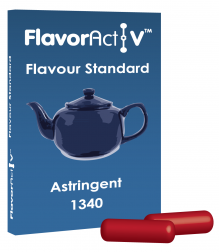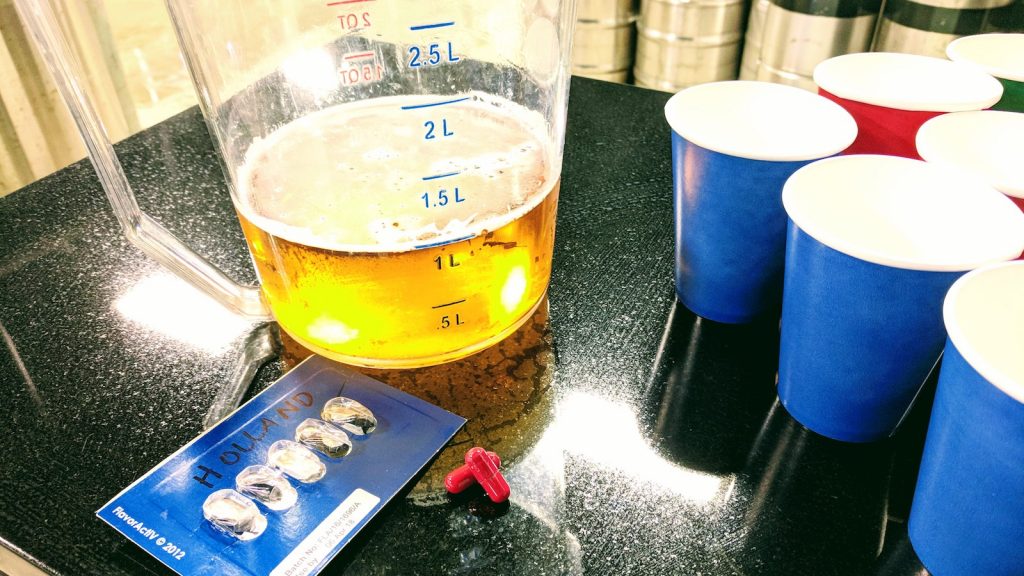Author: Malcolm Frazer
Of the various things that can be wrong in a beer, one of the more difficult to nail down is astringency due to the fact it is a tactile sensation rather than a characteristic perceived by other senses such as taste and smell. Often and understandably confused with bitterness, astringency differs in that, by definition, it leads to the constricting of body tissue, which produces an autonomic puckering sensation, tightening of the jaw muscles, and/or a fuzziness on the tongue. The astringent responsible for these experiences in beer are  polyphenols called tannins that exist in seeds, like barley, and vascular plants, like hops. They’re also present in hardwoods like those used to barrel age beer, in which case a minimal amount of astringency may be stylistically appropriate.
polyphenols called tannins that exist in seeds, like barley, and vascular plants, like hops. They’re also present in hardwoods like those used to barrel age beer, in which case a minimal amount of astringency may be stylistically appropriate.
Generally, astringency is considered an undesirable trait in nearly every style and is occasionally cited as a reason for reduced scores by competition judges. Since tannin extraction is positively correlated with pH, brewers looking to avoid this characteristic are advised to adjust their mash using acid to ensure the pH stays within an appropriate range, the popular recommendation being 5.2 to 5.6, give or take. Astringency can also be caused by the heavy use of hops and has been noted to be more prevalent in highly dry hopped styles, making new products such as Cryo Hops all the more appealing.
With its similarities to bitterness, we were curious if tasters would be able to tell apart a beer intentionally dosed with astringent flavor standard from a unadulterated sample of the same beer and put it to the test!

| PURPOSE |
To evaluate the ability of blind tasters to distinguish between a pale lager dosed with astringent flavor standard from an unadulterated sample of the same beer.
| METHODS |
In order to keep me blind to the off-flavor for my own trials, all identifying labels were removed from the flavor standard packaging prior to me receiving them. Wanting to ensure the off-flavor had the best chance of being perceived, I relied on a technique I recently learned is commonly used in beer sensory analysis and made three 50/50 blends of Miller High Life and Miller Lite, dosing just one with with the flavor standard.
Since tannins are present to some degree in all beers and come from various sources, it’s difficult to define a threshold at which humans can typically perceive the astringency they impart. While FlavorActiv does not provide the specific threshold of their astringent flavor standard, they recommend dosing 1 liter of beer with 1 capsule  in order to ensure a perceptible concentration. I prepared the dosed sample per the instructions provided by FlavorActiv by first gently pouring about 200 mL of beer into a pitcher, adding the contents of 2 flavor standard capsules, gently swirling, then adding an additional 1800 mL of beer to the vessel. The non-dosed samples were treated similarly to ensure no differences caused by anything other than the off-flavor.
in order to ensure a perceptible concentration. I prepared the dosed sample per the instructions provided by FlavorActiv by first gently pouring about 200 mL of beer into a pitcher, adding the contents of 2 flavor standard capsules, gently swirling, then adding an additional 1800 mL of beer to the vessel. The non-dosed samples were treated similarly to ensure no differences caused by anything other than the off-flavor.
| RESULTS |
Data for this xBmt was collected during a TRUB Homebrewers meeting being held at Voodoo Brewery. In total, 19 people with varying levels of experience, all blind to the variable, were served 1 sample of the beer intentionally dosed with astringent flavor standard and 2 samples of the clean beer in different colored opaque cups then instructed to select the unique sample. In order to reach statistical significance, 11 tasters (p<0.05) would have had to accurately identify the dosed sample, while only 6 (p=0.65) were capable of doing so. These results suggest participants in this xBmt were unable to reliably distinguish a beer intentionally dosed with astringent flavor standard from a clean sample of the same beer.
The 6 participants who correctly selected the unique sample in the triangle test were instructed to complete a brief set of additional questions comparing only the two different beers, still blind to the nature of the xBmt. First, they were asked to select the beer they thought was dosed with the off-flavor and 4 people chose correctly. Tasters were then asked to select from a list the off-flavor they thought the beer was dosed with. Not a single participant correctly identified astringent, 2 selected diacetyl, and 1 each chose oxidized, metallic, acetaldehyde, and chlorophenol.
My Impressions: Unaware of the off-flavor used in this xBmt until after data collection, I found the spiked sample particularly difficult to detect, though I was able to pick it out in a semi-blind triangle test. I got flummoxed when I detected no differences between the beers upon initially tasting them. I was eventually able to sense what I thought was a slightly sharper bitterness in one of the samples, which left me torn between astringency and bitterness. My final decision, a 50/50/90 semi-educated guess, was based on the fuzzy prickly sensation I experienced in my mouth upon my initial taste and swallow– astringency. This was not an easy choice, the difference was less obvious than I would have expected, and it’s possible I had a slight advantage since I’d been undergoing some sensory training in preparation for the Certified Cicerone exam.
| DISCUSSION |
Tannins are real, they are present in beer, and they do lead to astringency. That’s undeniable. However, the fact tasters in this xBmt could not reliably tell apart a beer intentionally dosed with astringent flavor standard from a clean sample calls into question just how good us humans are at accurately detecting astringency. Considering the non-significant results from a recent xBmt on high mash pH, which is perhaps the most commonly cited culprit of astringency in beer, it seems plausible this oft noted foible is occasionally mistaken for something else. And what about beers made relying on the decoction method where portions of the mash are literally boiled? Contrarily, these beers are usually lauded for being generally smooth in character.
Another source of astringency is hops, particularly when they include high amounts of leaf and stem material, and I certainly feel like I’ve noticed a tannic bite when tasting a beer soon after adding a large dry hop charge. It’s not good, but it always seems to fade, which again leads me to question the accuracy of judges who claim to perceive astringency in an otherwise fine beer that hasn’t been aged on wood.
As a judge of many years, I’ve made my fair share of checks in the astringency box on scoresheets, and while I’ve tended to avoid it lately, I can’t help but question the veracity of those earlier evaluations. Astringency being a sensory perception, there really isn’t a good way to objectively measure its presence in beer, and given the aforementioned results, I’m not sure it’s as common as I’ve been led to believe, which leaves me feeling a lot less anxious.
If you have any thoughts about this xBmt, don’t hesitate to share them in the comments section below!
Support Brülosophy In Style!
All designs are available in various colors and sizes on Amazon!
Follow Brülosophy on:
FACEBOOK | TWITTER | INSTAGRAM
If you enjoy this stuff and feel compelled to support Brulosophy.com, please check out the Support Us page for details on how you can very easily do so. Thanks!












19 thoughts on “exBEERiment | FlavorActiV Off-Flavor Series: Astringency In A Pale Lager”
Can you share more about the “technique I recently learned is commonly used in beer sensory analysis and made three 50/50 blends of Miller High Life and Miller Lite”. Is that really a thing?
It’s something performed on several sensory analysis and sensory training platforms. Not necessarily those two beers but blending beers in general. Part of the mindset is to not make it taste like one beer in particular. So instead of the beer directly presenting itself as Miller Lite, Coors Light, Sam Light, Amstel, Stella…. It tastes of something inbetween.
In fact, at some of the higher levels of training or testing, for example Advanced or Master Cicerone, they may even use a portion of a pale ale such as Sierra Nevada. Because people should be able to detect these off flavors in beers other than a pale light lager. Training is different than testing of course. Training may just involve getting people to hone in on the concept of the spike. To recognize it.
In our particular case, for this experiment, we’re not training, we’re instead testing to see if people could detect it. In my opinion it would have been neat to try it in a pale ale – straight up.
Astringency (as well as diacetyl) has become a scapegoat for novice tasters. It is not as prevalent as some believe. Astringency is real but I rarely pick it up in competitions. I do think it was more common like 10 or 15 years ago. The homebrewing community is more careful now to control mash pH and sparge volume to avoid it.
One of my recent dry-hopped homebrew had some hop particulate left in suspension at the bottom of each bottle, which when poured out had formed a thick green sludge with the yeast. Obviously FOR SCIENCE I tried some, and that’s when I learned what astringency tastes like.
Nice reading Malcolm. Makes one think 🙂
I would hypothesize that almost 100% of the population would detect tannic astringency at a high level. If you indulge that I reason based on a hypothesis I have not researched 🙂 I wonder why FlavorActiv recommends dilution to a concentration that cannot be detected as astringency by any of the 19 participants. FlavorActiv has indicated to me that they use the work of Meilgaard as basis for their standards, and Meilgaard used quercitrin (which is not a tannin) as his astringent compound for the standard. I wonder if quercitrin would give more of a tonic water (quinine) type astringency, which is a flavor more similar to hops and thus more difficult to detect if one does not know what to look for.
Hey Lup,
I know that other flavor spike houses use different compounds for their various spikes/ taints.
Aroxa, for example, has a few examples “tannins” or ” astringency”.
For what it’s worth, I was able to detect it but I’ve been doing sensory training quite a bit lately. Because I believe that on average most people are average (lol), I’m led to believe that a greater number of those tested would be able to detect the sensation with some training.
That doesn’t mean that their natural physical receptive ability is changed. Instead, they just are given techniques on how to hone into certain things and eliminate the noise if you will.
For example, in my case, because I couldn’t smell it and it didn’t have a strong flavor, I started eliminating certain flavor spikes that it most likely wasn’t and started looking for the few that I thought it might be.
And that’s why I find it interesting to give off flavors spikes to people who aren’t recently trained (potentially making them more aware). Some of those people on that panel were trained judges. But the last time they may have been introduced to astringency, especially as a flavor spike, and then talked about it and tasted actively, may have been one two or more years ago.
In the days before I adjusted my mash pH, I’d make IPA’s that I perceived as being astringent, when really, they were probably just harsh from the hop bitterness. My theory is that my high mash pH was dramatically increasing my hop utilization, causing this more harsh bitterness. Once I started dialing in a 5.3 mash ph, the same recipe yielded noticeably smoother beers.
I recently brewed a heavily saaz hopped bohemian pils and wanted that smooth character, so I targeted a 4.8pH and it worked like a charm! Great hop flavor with a smooth bitterness and a full body.
Mash pH or was 4.8 for the final beer?
I’ve had very few astringent beers. If you want to experience astringency the easiest is to get some dry cider. A strong single variety with a bitter-sharp like Tremletts Bitter will dry your mouth as it had been sandpapered. Then you’ll suck in your lips like a trout and enjoy the apply burn. Delicious. Most farmhouse ciders in the West Country will have a decent astringency in the blend.
Or a super oaked red wines like Nebbiolo, a Nappa Cab, or Monastrell!
They can coat your mouth with tannins!
It’s been a long time since I was in England, and able to get those small boutique super dry ciders. I miss them.
Young Cahors can do the trick too. Old dry sherries (amontillados from Sanlucar are a good example) also pack plenty. Quo Vadis by Delgado Zuleta is a good example (a sherry that tastes like salty nail polish blended with turpentine aged in American oak). Few are as astringent as tannic cider, though.
Thanks for Sharing, Jkaranka. Perhaps that may help some other people experience astringency.
This makes sense for sure, I’ve personally found it somewhat difficult to pick up astringentcy. I’ve always been a fan of bitter/hoppy beer along with foods and other drinks so that doesn’t help.
Until recently, I’ve noticed what I percieved to be astringentcy in certain local breweries well dry hopped beers, which has led me to think that’s what im getting. Also thinking that’s what’s happening to my heavily hopped/dry hopped ipas.
Now im thinking it’s not necessarily astringentcy, and more so a harshness from the massive amount of hops/material and drinking them pretty young, which btw I’ve always personally thought it was. I never really got the puckering or fuzziness of astringentcy from my beers. (I will probably go with less hops next time to see if there is any difference and see what I percieve. Thanks for the article! Always enjoy these, and the comments as well. Cheers! Will also have to train myself more to actually get the sense of a truly astringent beer.
I hate to say it but the taste of earwax is a good example of ‘astringent’. Gross though obviously
How… umm… how do you know?
We were all kids once, huh
Another thing that can give you a similar sensation are Szechuan peppers. Not quite astringent as such but definitively more of a sensation than a flavour.
The simple taste test for astringency, to get your tastebuds around the phenomena so to speak, is very, very simple. Unsweetened tea (Camellia sinensis). Green, black or oolong, it doesn’t matter, but make a strong tea and drink it unadulterated. The polyphenols in tea are the classic textbook example of astringency. I use green tea tinctures to make store bought apple juice into drinkable cider, replacing the polyphenols that cider-apple varieties supply.
I agree. Tea and oaky wine come to mine when I think of astringency.
Thanks for the tip about green tea tincture for juice based cider. Do you make the tincture? How? What dosage do you recommend?
I don’t care for completely fermented juice cider, but have found back-sweetening with concentrated juices changes everything. Looking forward to testing tea